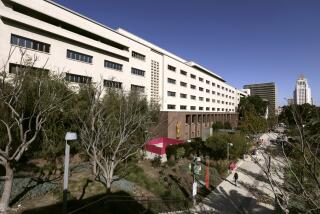Seismic Plan for Pasadena City Hall OKd by Council
- Share via
Pasadena, a city where historic preservation is much like a civic obsession, will undertake an $89-million seismic strengthening and renovation of its Beaux Arts City Hall, which experts say would be destroyed in a major earthquake.
The unanimous City Council decision about 1 a.m. Tuesday culminated more than 10 years of analysis and debate over how to best preserve the crown jewel of downtown Pasadena, a landmark building with an enormous dome.
“This is a major step,” said Mayor Bill Bogaard of the council’s go-ahead to begin planning and environmental reviews.
“It’s as big a project for Pasadena as the renovation of L.A. City Hall, Oakland or San Francisco--not in dollars, but in complexity of construction,” said City Manager Cynthia Kurtz.
Council members left unsettled how the city will pay for the overhaul, the costliest public works project in Pasadena in decades. Council members called for additional financial studies.
Tentative plans call for about $67 million to come from bonds that would be paid back over 25 years, with annual payments of about $5.6 million. About $3 million a year would be taken from the coffers of the city’s Department of Water and Power. The rest would come from other general fund sources.
Under today’s projections, utility rates will not be increased to pay for City Hall, Kurtz said.
Under a worst-case scenario, she said, if the city’s utility could not absorb the bond debts and there was no other means to pay them, the average residential utility bill could be increased as much as $24 a year.
To reduce the overall cost, the city already has secured a $7-million federal grant and saved $5.5 million for the project, which will require moving about 350 City Hall employees out for the three-year construction period.
Councilmen Chris Holden and Paul Little were not sure they wanted to burden the utility with paying for about half the City Hall debt.
“We are talking about a 25-year obligation,” said Little. “We need to ensure we do not jeopardize the future of the Pasadena my kids will live in.”
But the future of Pasadena’s civic center is largely tied to the vibrancy of its historic downtown buildings--envisioned in 1921 as the “Athens of the West”--with City Hall, the library and the civic auditorium all linked by grand boulevards.
Last fall, the city’s new Paseo Colorado opened with a retail and entertainment complex and apartments built on top.
The $200-million project was intended to invigorate the lackluster civic center area less than a mile east of the popular Old Pasadena district.
Much of the debate over the years has focused on finding a way to strengthen the building and preserve the architecture, which is Beaux Arts Classicism with Spanish Mission elements.
City Hall is a complicated structure with a seismically weak dome and arcade area as its centerpiece, connected to three office wings.
A seismic study five years ago found that the building’s three-story wings would collapse into the spacious interior courtyard in a major quake.
The study said the columns supporting the arched corridors also could fail and the dome could crash down in a magnitude-7 quake on a local fault or a magnitude-8 temblor on the San Andreas fault.
Kurtz told council members that if they did not approve the seismic strengthening, she would be forced to move City Hall employees to another site for their safety.
The council approved a strengthening program that entails installing shock absorbers called base isolators--steel plates layered with a rubber compound--under the building’s 272 support columns.
More to Read
Sign up for Essential California
The most important California stories and recommendations in your inbox every morning.
You may occasionally receive promotional content from the Los Angeles Times.











